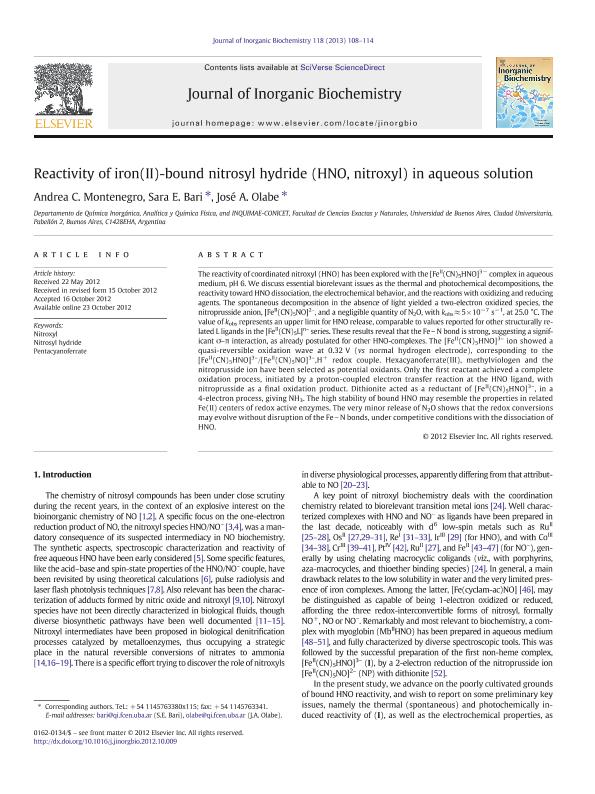Mostrar el registro sencillo del ítem
dc.contributor.author
Montenegro, Andrea C.
dc.contributor.author
Bari, Sara Elizabeth

dc.contributor.author
Olabe Iparraguirre, Jose Antonio

dc.date.available
2015-07-22T21:25:58Z
dc.date.issued
2013-01
dc.identifier.citation
Montenegro, Andrea C.; Bari, Sara Elizabeth; Olabe Iparraguirre, Jose Antonio; Reactivity of iron(II)-bound nitrosyl hydride (HNO, nitroxyl) in aqueous solution; Elsevier Science Inc; Journal of Inorganic Biochemistry; 118; 1-2013; 108-114
dc.identifier.issn
0162-0134
dc.identifier.uri
http://hdl.handle.net/11336/1398
dc.description.abstract
The reactivity of coordinated nitroxyl (HNO) has been explored with the [FeII(CN)5HNO]3 - complex in aqueous medium, pH 6. We discuss essential biorelevant issues as the thermal and photochemical decompositions, the reactivity toward HNO dissociation, the electrochemical behavior, and the reactions with oxidizing and reducing agents. The spontaneous decomposition in the absence of light yielded a two-electron oxidized species, the nitroprusside anion, [FeII(CN)5NO]2-, and a negligible quantity of N2O, with kobs ≈ 5 × 10- 7 s- 1, at 25.0 °C. The value of kobs represents an upper limit for HNO release, comparable to values reported for other structurally related L ligands in the [FeII(CN) 5L]n- series. These results reveal that the FeN bond is strong, suggesting a significant σ-π interaction, as already postulated for other HNO-complexes. The [FeII(CN)5HNO]3- ion showed a quasi-reversible oxidation wave at 0.32 V (vs normal hydrogen electrode), corresponding to the [FeII(CN)5HNO] 3-/[FeII(CN)5NO]3-,H+ redox couple. Hexacyanoferrate(III), methylviologen and the nitroprusside ion have been selected as potential oxidants. Only the first reactant achieved a complete oxidation process, initiated by a proton-coupled electron transfer reaction at the HNO ligand, with nitroprusside as a final oxidation product. Dithionite acted as a reductant of [FeII(CN)5HNO] 3-, in a 4-electron process, giving NH3. The high stability of bound HNO may resemble the properties in related Fe(II) centers of redox active enzymes. The very minor release of N2O shows that the redox conversions may evolve without disruption of the FeN bonds, under competitive conditions with the dissociation of HNO.
dc.format
application/pdf
dc.language.iso
eng
dc.publisher
Elsevier Science Inc

dc.rights
info:eu-repo/semantics/openAccess
dc.rights.uri
https://creativecommons.org/licenses/by-nc-sa/2.5/ar/
dc.subject
NITROSYL HYDRIDE
dc.subject
NITROXYL
dc.subject
PENTACYANOFERRATE
dc.subject.classification
Química Inorgánica y Nuclear

dc.subject.classification
Ciencias Químicas

dc.subject.classification
CIENCIAS NATURALES Y EXACTAS

dc.title
Reactivity of iron(II)-bound nitrosyl hydride (HNO, nitroxyl) in aqueous solution
dc.type
info:eu-repo/semantics/article
dc.type
info:ar-repo/semantics/artículo
dc.type
info:eu-repo/semantics/publishedVersion
dc.date.updated
2016-03-30 10:35:44.97925-03
dc.journal.volume
118
dc.journal.pagination
108-114
dc.journal.pais
Estados Unidos

dc.description.fil
Fil: Montenegro, Andrea C.. Consejo Nacional de Investigaciones Científicas y Técnicas. Oficina de Coordinación Administrativa Ciudad Universitaria. Instituto de Química, Física de los Materiales, Medioambiente y Energía. Universidad de Buenos Aires. Facultad de Ciencias Exactas y Naturales. Instituto de Química, Física de los Materiales, Medioambiente y Energía; Argentina
dc.description.fil
Fil: Bari, Sara Elizabeth. Consejo Nacional de Investigaciones Científicas y Técnicas. Oficina de Coordinación Administrativa Ciudad Universitaria. Instituto de Química, Física de los Materiales, Medioambiente y Energía. Universidad de Buenos Aires. Facultad de Ciencias Exactas y Naturales. Instituto de Química, Física de los Materiales, Medioambiente y Energía; Argentina
dc.description.fil
Fil: Olabe Iparraguirre, Jose Antonio. Consejo Nacional de Investigaciones Científicas y Técnicas. Oficina de Coordinación Administrativa Ciudad Universitaria. Instituto de Química, Física de los Materiales, Medioambiente y Energía. Universidad de Buenos Aires. Facultad de Ciencias Exactas y Naturales. Instituto de Química, Física de los Materiales, Medioambiente y Energía; Argentina
dc.journal.title
Journal of Inorganic Biochemistry

dc.relation.alternativeid
info:eu-repo/semantics/altIdentifier/doi/http://dx.doi.org/10.1016/j.jinorgbio.2012.10.009
dc.relation.alternativeid
info:eu-repo/semantics/altIdentifier/url/https://www.sciencedirect.com/science/article/pii/S0162013412003388
Archivos asociados
